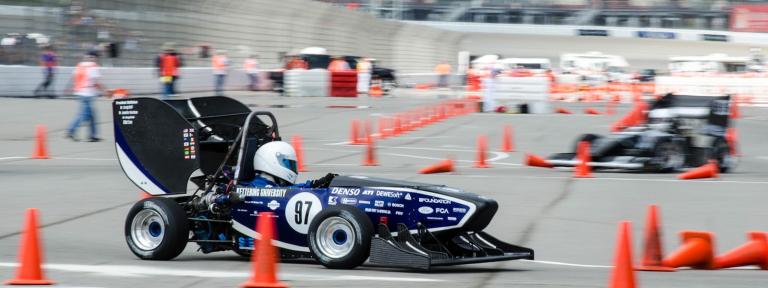
It’s been two years in the making, but Kettering University’s Formula team thinks it has been worth the wait, and the effort. “It” is the team’s most recent car design, which has produced a lighter, safer, better performing car.
“The Formula SAE team has done an excellent job of designing and building this car,” said Dr. Craig Hoff, professor of Mechanical Engineering and faculty adviser for the Formula SAE team at Kettering.
“The vehicle came in under 400 pounds, which is 100 pounds lighter than previous efforts,” he added. Hoff credits the strong design to the number of upper classmen on the team. The students themselves agree, saying that an older team brings more experience to the design/build process.
They had an opportunity to test their design in the field at the Formula West competition in California June 16 through 20, at the California Speedway in Fontana. Formula SAE is one of the Society of Automotive Engineers Collegiate Design Series competitions intended to give students real-world engineering design experience.
The Kettering team won first place in Crash Attenuator Design at the Formula West competition, placed 18th overall, eighth in endurance and third in fuel economy. They were one of 20 teams out of 47 to complete all the competition events, receiving a score in every event.
“The California competition gave us a chance to fine tune our design,” said Matt Birt, of Urbana, Ohio, A-Section lead technical engineer for the team. Birt and his teammates see this as their competitive edge for the Formula SAE Midwest Competition in Detroit in May 2010.
SAE rules stipulate that vehicle designs cannot be used two years in a row for the same event, so running their car in California in 2009 and Michigan in 2010 allows the team more time for testing and tweaking. And they have their sights set high for 2010.
“The Midwest Formula competition is bigger than the Formula West competition, with about 100 teams participating,” Birt said, “and there are international teams involved, which intensifies the competition.”
The testing and tweaking continues over both A and B sections as the team prepares for the Midwest competition. “Teams that do more testing tend to perform better overall,” said Birt, adding “it separates the good teams from the great teams.”
“It completes the design cycle,” explained Quinn Griesdale, of Victoria, British Columbia. “We designed the car, built the car and we want to know if the design works as well as we intended.”
The design features a chassis and suspension designed by Griesdale, a single-cylinder engine versus the more traditional four-cylinder (contributing to the 100 pounds lighter weight) an impact or crash attenuator that was tested in real crash events in the Kettering Crash Safety Center lab and an “old school” carburetor.
According to team members who have driven the vehicle, it is comfortable and fast to drive thanks to Griesdale’s design. Team members were running more tests on campus recently, creating a safety cone track in the back parking lot behind the Recreation Center, and using an on-board ISAAC data acquisition system to better understand the car’s handling, grip and acceleration.
The smaller engine not only lightened the car, but, according to Birt, it did not compromise power. “We are down on power a little bit compared to a four-cylinder engine,” he explained, “but the power we have is less peaky and delivers a more usable power range.”
The crash attenuator was developed when SAE rules for the Formula cars required more safety features.Kettering’s team had a chance to perform a test cycle on their attenuator design last year, instead of guessing it would work in a real-world application.
They were able to utilize the Crash Safety Center lab’s crash sled to explore different shapes for crumple zones. They found that a square block did what they needed it to do and that welding the attenuator in multiple places avoided the problem presented when using bolts to hold it in place caused tears in the crumple zone.
The results of their research and testing on the attenuator actually influenced changes in the rules for SAE Formula racing, according to Hoff.
Team members were especially proud of their third place win in fuel economy in California because they were only one of two teams to use a carburetor instead of a fuel injector.
According to team member Jason Kane, of Cadillac, Mich., their “old school” carburetor is cheaper, simpler, starts every time and is “obviously good in fuel economy.” It also allowed the team to quickly calibrate the engine during competition, which offered them a time advantage on the track.
To further field test the car before the Midwest Formula competition, Kettering’s Formula team will compete in the University of Toronto “Shoot Out” in September at Mossport Raceway go cart track.
They will also work on their statics. “We built a great, dynamic car,” said Griesdale, “and we need to build up our written and oral presentations to do it justice.” Griesdale himself will have graduated before the Midwest event, but will join the team in Detroit to follow his “baby” through the final cycle – which he hopes will be a winning one.
Written by Dawn Hibbard
810.762.9865
dhibbard@kettering.edu